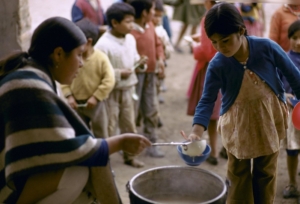Hunger in Ecuador — Assistance is Still Needed
 Ecuador, a country in Latin America with a population of 18.4 million, is classified as an upper-middle-income country. However, one in three children in Ecuador is malnourished, the second-highest rate in the region.
Ecuador, a country in Latin America with a population of 18.4 million, is classified as an upper-middle-income country. However, one in three children in Ecuador is malnourished, the second-highest rate in the region.
Ecuador’s Hunger Crisis
- Poverty– According to the latest statistics, Ecuador has made progress in reducing the poverty rate, which has decreased to 26% in recent years. However, it is still high in rural areas, with 40% of people living below the poverty line. The high levels of poverty in the country have led to a surge in crime and violence, as many young adults see crime as their only way out of poverty.
- Effects on Children– The alarming prevalence (14%) of malnourishment in the population has resulted in a concerning 23% of children under the age of 5 experiencing stunted growth. This condition has a detrimental impact on the learning and cognitive development of nearly one in five of these children, posing a significant threat to their overall well-being and future prospects.
- Worsening Food Insecurity– Food insecurity has increased in recent years, rising from around 20% before the pandemic to 33% in 2020. This is due to the global economic crisis, the influx of refugees from Venezuela and Colombia, natural disasters, food waste and the worsening security situation in the country. Around 900,000 tons of food is wasted or lost annually. The government passed a law recently to ensure safe-to-eat food is donated at designated places and incentives in the form of tax deductions, etc, are provided to the donors.
Efforts Underway
The World Food Programme (WFP) provides food assistance to around 300,000 people. The organization is also working in collaboration with the government to end malnutrition by focusing on pregnant and breastfeeding women and children under 2 to help reduce malnutrition and stunting in the population. The WFP is actively engaged in strengthening the capabilities of governmental institutions, equipping them with advanced tools and expertise to combat the ongoing crisis effectively.
In addition to the WFP’s efforts, Tetra Pak and the Ministry of Education have launched a collaborative pilot program to provide schoolchildren in targeted regions with 200 ml of nutritious milk daily, five days a week. The program’s goal was to combat malnutrition and reduce school dropouts. Following its success, the program has been formalized into legislation and implemented nationwide.
Looking Ahead
Despite all efforts, Ecuador still faces immense challenges in reducing hunger, food insecurity and malnutrition. The international focus and assistance on Ecuador have decreased recently because it is an upper-middle-income country, further exacerbating the problems. The need of the hour is to assist Ecuador in dealing with these issues by providing aid and assistance and helping it achieve Sustainable Development Goal 2 of zero hunger.
– Dustin Jayroe
Photo: Flickr
Updated: October 1, 2024
